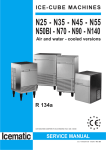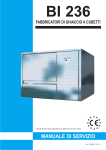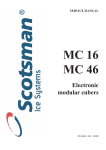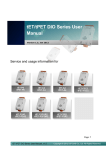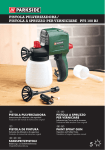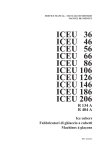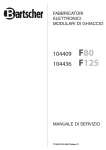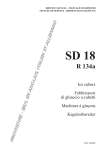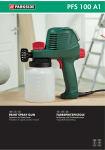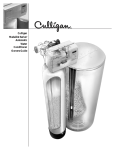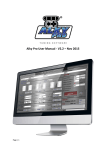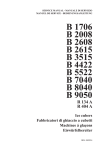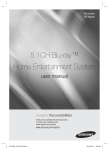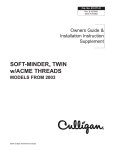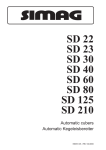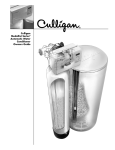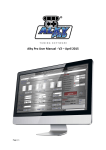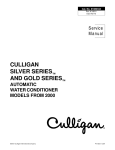Download N21s - IceParts
Transcript
N21 AUTOMATIC CUBERS OUR SYSTEMS CONFORM TO EC STANDARD 73/23 CEE - 89/336 SERVICE MANUAL Cod. 71503341/0 - 3/00 - GB PRODUTTORI DI GHIACCIO N 21 - ICE PRODUCTION N 21 PRODUCTION DE GLACE N 21- EIS PRODUCTION N 21 Temperatura acqua - Water temperature Température eau - Wassertermperatur °C 32° 21° 15° 10° 10° 17 20 22 23 kg 21° 16 19 21 22 kg 32° 14 17 19 20 kg 38° 13 16 18 17 kg Prod. ghiaccio in 24 h - Ice prod. per 24 h Prod. de glace en 24 h - Eisprod. in 24 h RAFFREDAMENTO AD ARIA - AIR COOLED REFR. A AIR - LUFTGEKÜHLT Temperatura ambiente - Ambient temperature Température ambiente - Raumtemperatur Temperatura ambiente - Ambient temperature Température ambiente - Raumtemperatur RAFFREDAMENTO AD ACQUA - WATER COOLED REFR. A EAU - WASSERGEKÜHLT Temperatura acqua - Water temperature Température eau - Wassertermperatur °C 32° 21° 15° 10° 10° 17 20 22 23 kg 21° 16 19 21 22 kg 32° 14 17 19 20 kg 38° 13 16 18 17 kg Prod. ghiaccio in 24 h - Ice prod. per 24 h Prod. de glace en 24 h - Eisprod. in 24 h (*) con temperatura ambiente 32 °C e con temperatura acqua 21 °C - with room temperature 32 °C and water temperature 21 °C avec température ambiente 32 °C et température eau 21 °C - mit Raumtemperature 32 °C und Wassertemperatur 21 °C SPECIFICHE TECNICHE - TECHNICAL SPECIFICATIONS SPECIFICATIONS TECHNIQUES - TECHNISCHE ANGABEN N 21 Alimentazione elettrica - Electric voltage - Alimentation électrique - Normale Netzpannung Condensazione - Condensation - Condensation - Kühlung N21 W 220-240/50/1 -10÷+6% Aria - Air Air - Luft Acqua - Water Eau - Wasser Capacità contenitore (kg) - Bin Capacity (kg) - Capacité bac (kg) - Speiker Kapazität (kg) 6,5 Peso netto (kg) - Net weight (kg) - Poids net (kg) - Netto Gewicht (kg) 29 Potenza compressore CV - Compressor power HP - Puissance compresseur CV - Kompressorleistung PS 1/5 Amperaggio di marcia - Running amps - Ampérage en marche - Ampere 2.2 Amperaggio d’avv. - Start amps - Ampérage de démarr. - Start Ampere 9.1 Potenza - Power (Watts) - Puissance (Watts) - Leistung (Watt) 350 Consumo elettr. in 24 ore (Kwh) - Power cons. in 24 hrs (Kwh) Cons. electr. en 24 hrs (Kwh) - Stromverbrauch in 24 std (Kwh) 7.5 Selezione cavi (mm2) - Wire size (mm2) - Section fils (mm2) - Kabelanzahl (mm2) Carica refrig. R 134 a (gr) - Refrig. charge R 134 a (gr) - Charge refrig. R 134 a (gr) - Kühlmittel Füll. R 134 a(gr) Dispositivo d’espansione - Refrigerant metering device - Détente du Rèfrigérant - Kältemittel-Expansionssystem 3x1 210 190 Tubo Capillare - Capillary tube Tube capillaire - Kapillarrohor PRESSIONI DI FUNZIONAMENTO - OPERATING PRESSURES PRESSIONS DE FONCTIONNEMENT - BETRIEBSDRÜCKE Pressione di mandata - Discharge pressure - Pressions de fonctionnement - Hochdruckbereich Raffreddamento ad aria (21°C) - Air cooled (21°C) - Refroidissement par air (21°C) - Luftgekühlt (21°C) Raffreddamento ad acqua - Water cooled - Refroidissement par eau - Wassergekühlt N 21 8.5/7 bar 8/10 bar Pressione di aspirazione - Suction pressure - Basse pression - Niederdrück Fine ciclo di congelamento - End of freezing cycle - Fin cycle de congelation - Ende der Gefrierfase 1/0.2 bar GB GENERAL INFORMATION AND INSTALLATION A. INTRODUCTION This manual provides the specification and the step-bystep procedures for the installation, start-up and operation, maintenance and cleaning for the Icemakers. The machine cubers are quality designed, engineered and manufactured. Their ice making systems are thoroughly tested providing the utmost in flexibility to fit the needs of a particular user. This product qualifies for the following listings: These icemakers have been engineered to our own rigid safety and performance standards. The VDE - SEV - WRC seals signifity that it is listed with them and that it complies with the materials and manufacturing standard of them. These seals also signify that these icemaker models have been inspectors who reserve the right to periodically examine production icemakers at the factory to assure continued compliance. 5. Remove all internal support packing and masking tape. 6. Check that refrigerant lines do not rub against or touch other lines or surfaces, and that then fan blades move freely. 7. Check that the compressor fits snugly onto all its mounting pads. 8. See data plate on the rear side of the unit and check that local main voltage corresponds with the voltage specified on it. CAUTION. Incorrect voltage supplied to the icemark will void your parts replacement program. 9. Remove the manufacturer’s registation card from the inside of the User Manual and filling all parts including: Model and Serial Number taken from the data plate. Forward the completed self-addressed registration card to the factory. C. LOCATION AND LEVELLING WARNING. NOTE. To retain the safety and performance built into this icemaker, it is important that installation and maintenance be conducted in the manner outlinde in this manual. B. UNPACKING AND INSPECTION 1. Call your authorized Distributor or Dealer for proper installation. 2. Visually inspect the exterior of the packing and skid. Any severe damage noted should be reported to the delivering carrier and a concealed damage claim form filled in subjetto inspection of the contents with the carrier’s representative present. 3. a) Cut and remove the plastic strip securing the carton box to the skid. b) Remove the packing nails securing the carton box to the skid. c) Cut open the top of the carton and remove the polystyre protection sheet. d) Pull out the polystyre posts from the corners and then remove the carton. 1. Position the storage bin in the selected permanent location. Criteria for selection of location include: a) Minimum room temperature 10°C (50°F) and maximun room temperature 40°C (100°F). b) Water inlet temperatures: minimum 5°C (40°F) and maximum 40°C (100°F). c) Well ventilated location for air cooled models (clean the air cooled condenser at frequent intervals). d) Service access: adequate space must be left for all service connections through the rear of the ice maker. A minimum clearance of 15 cm (6”) must be left at the sides of the unit for routing cooling air draw into and exhausted out of the compartment to maintain proper condensing operation of air cooled models. NOTE. With the unit in “built-in” conditions, the ice production is gradually reduced in respect to the levels shown in the graph, up to a maximum of 10% at room temperatures higer than 32°C. The daily ice-making capacity is directly related to the condenser air inlet temperature, water temperature and age of the machine. To keep your CUBER at peak performance levels, periodic maintenance checks must be carried out as indicates on this manual. 4. Remove the front and the sides panels of the unit and inspect for any concealed damage. Notify carrier of your claim for the concealed damage as stated in step 2 above. 17 GB 2. Level the Icemaker in both the left to right and front to rear directions by means of the adjustable legs. D. ELECTRICAL CONNECTIONS See data plate for current requirements to determine wire size to be used for electrical connections. All icemakers require a solid earth wire. All ice machines are supplied from the factory completely pre-wired and require only electrical power connections to the wire cord provided at the rear of the unit. Make sure that ice machine is connected to its own circuit and individually fused (see data plate for fuse size). The maximum allowable voltage variation should not exceed -10% and +6% of the data plate rating. Low voltage can ucause faulty functioning and may be responsible for serious damage to overload switch and motor windings. NOTE. All external wiring should conform to national, state and local standards and regulations. Check voltage on the line and the ice maker’s data plate before connecting the unit. E. WATER SUPPLY AND DRAIN CONNECTIONS GENERAL When choosing the water supply for ice flaker consideration should be given to: a) Length of run b) Water clarity and purity c) Adequate water supply pressure 18 Since water is the most important single ingredient in producing ice you cannot emphasize too much the three items listed above. Low water pressure, below 1 bar may cause malfunction of the ice maker unit. Water containing excessive minerals will tend to produce cloudy colored ice cubes, plus scale build-up on the inerior parts of the water system. WATER SUPPLY Connect the 3/4” GAS male of the water inlet fitting, using the food grade flexible tubing supplied with the machine, to the cold water supply line with regular plumbing fitting and a shut-off valve installed in an accessible position between the water supply line with regular plumbing fitting and a shut-off valve installed in an accessible position between the water supply line and the unit. If water contains a high level of impurities, it is advisable to consider the installation of an appropriate water filter or conditioner. WATER DRAIN Connect the drain fitting with a plastic tube to an open trapped and vented drain. When the drain is a long run, allow 3 cm pitch per meter (1/4” pitch per foot). On water cooled versions, the water drain line from the condenser is internally connected with the drain fitting of the unit. It is strongly recommended therefore to install a vertical open vent on unit drain line high point to ensure good draining and to direct the drain line to a trapped and vented floor drain receptacle NOTE. The water supply and the water drain must be installed to conform with the local code. In some case a licensed plumber and/or a plumbing permit is required. GB F. FINAL CHECK LIST 1. Is the unit in a room where ambient temperatures are within a minimum of 10°C (50°F) even in winter months? 2. Is there at least a 15 cm (6”) clearance arround the unit for proper air circulation? 3. Is the unit level? (IMPORTANT) 4. Have all the electrical and plumbing connections been made, and is the water supply shut-off valve open? 5. Has the voltage been tested and checked against the data plate raiting? 6. Has the water supply pressure been checked to ensure a water pressure of at least 1 bar (14 psi). 7. Have the bolts holding the compressor down been checked to ensure that the compressor is snugly fitted onto the mounting pads? 8. Check all refrigerant lines and conduit lines to guard against vibrations and possible failure. 9. Have the bin liner and cabinet been wiped clean? 10. Has the owner/user been given the User Manual and been instructed on the importance of periodic maintenance checks? 11. Has the Manufacturer’s registration card been filled in properly? Check for correct model and serial nuber against the serial plate and mail the registration card to the factory. 12. Has the owner been given the name and the phone number of the authorized Service Agency serving him? G. INSTALLATION PRACTICE 1. Hand shut-off valve 2. Water filter 3. Water supply line (flexible hose) 4. 3/4” GAS male fitting 5. Vented drain 6. Open trapped vented drain 7. Drain fitting 8. Main switch 9. Power line WARNING This icemaker is not designed for outdoor installation and will not function in ambient temperatures below 10°C (50°F) or above 40°C (100°F). This icemaker will malfunction with water temperatures below 5°C (40°F) or above 40°C (100°F). 19 GB OPERATING INSTRUCTIONS OPERATIONAL CHECKS START UP C. At completion of the water filling phase the unit initiate automatically the first freezing cycle with the start up of (Fig.1): After having correctly installed the ice maker and completed the plumbing and electrical connections, perform the following "Start-up" procedure. A. The model N 21 has to be operated by switching "on" the master switch on the power line or, in case this last one has not been fitted, by merely plugging in its electric cord into an adequate receptacle. NOTE. The icemaker control is factory set with the timer microswitches actuators dropped off into the initial point of the cam slot. This setting position allows a proper water filling. The unit starts operating in the "defrost cycle" with the following components being activated: THE THE THE THE WATER INLET SOLENOID VALVE HOT GAS SOLENOID VALVE COMPRESSOR TIMER MOTOR B. During the water filling operation, check to see that the incoming water dribblers, through the evaporator platen dribbler holes, down into the sump reservoir to fill it up and also that the incoming surplus of water flows out through the overflow pipe into the drain line. NOTE. If, in the defrost cycle length, the machine sump reservoir does not get filled with water up to the rim of the overflow pipe, remove the front panel and rotate the shaft of the timer so to cause the dropping of the two microswitches actuators into the beginning of the cam slot and check for: 1. The water pressure of the water supply line, it must be at least 1 bar (14 psig) Minimum (Max 5 bar-70 psig). 2. The filtering device installed in the water line that may reduce the water pressure below the Minimum value of 1 bar (14 psig). 3. Any clogging situation in the water circuit like the inlet water strainer and/or the flow control. 20 COMPRESSOR WATER PUMP FAN MOTOR (in air cooled version) D. Check to see through the ice discharge opening that the spray system is correctly seated and that the water jets uniformely reach the interior of the inverted mold cups or the exterior of the evaporator tips; also make sure that the plastic curtain is hanging freely and there is not excessive water spilling through it. E. The ice making process takes place thereby, with the water sprayed into the molds oron to the tips that gets gradually refrigerated by the heat exchange with the refrigerant flowing into the evaporator serpentine. During the first portion of the freezing cycle, the timer assy is standing-by with its microswitches actuators resting on the raised cam profile (position that correspond to the end of the defrost cycle). F. Then, as the cube size control cut-in point is Reached by the evaporator temperature the control of the cycle is passed to the timer assy. Whose raised cam slowly rotates to continue the freezing cycle (2nd phase) up to its completition. The components in operation during this 2nd phase of the cycle are (Fig.2): COMPRESSOR WATER PUMP FAN MOTOR (in air cooled version) TIMER MOTOR G. After about 18÷20 minutes from the beginning of the freezing cycle, in an hypothetic ambient temperature of 21°C, the defrost cycle takes place with the hot gas and the water in let valves being simoultaneously activated. The electrical components in operation are (Fig.3): COMPRESSOR WATER INLET SOLENOID VALVE HOT GAS VALVE TIMER MOTOR H. Check, during the defrost cycle, that the incoming water flows correctly into the sump reservoir in order to refill it and that the surplus overflows through the overflow drain tube. GB I. Check the texture of ice cubes just released. They have to be of the right size with a thickness of about 7÷8 mm. If the ice cubes have not the correct size, wait for a second harvest before attempting any adjustment by setting the cube size control. By rotating the control setting screw clockwise the ice cube thickness can be increased; on the contrary the thickness can be reduced by turning the setting screw counterclockwise. If the ice cubes are shallow and cloudy, it is possible that the ice maker runs short phase or, the quality of the supplied water requires the use of an appropriate water filter or conditioner. J. With the icemaker in the harvest cycle, hold ice against the bin thermostat control bulb to test its shut off (Fig.4). This should cause the ice maker to shut OFF after 30 seconds, 1 minute at the most, namely when the control bulb temperature drops to reach + 1°C. NOTE. In case this test is performed during the freezing cycle, the unit will shut OFF only at the end of the freezing cycle and exactly when the timer switch actuatours drop-off into the cam slot (Fig. 5) Within minutes after the ice is removed from the sensing bulb, the bulb will warm up to reach +4°C and consequently will cause the icemaker to restart from the harvest (defrost) cycle. K. Instruct the owner/user on the general operation of the general operation of the ice machine and about the cleaning and care it requires. 21 GB PRINCIPLE OF OPERATION In the cube ice makers the water used to make the ice is kept constantly in circulation by an electric water pump which primes it to the spray system nozzles from where it is diverted into the molds of the evaporator. A smoll quantity of the evaporator. A small quantity of the sprayed water freezes into ice; the rest of it cascades by gravity into the sump assembly below for recirculation. FREEZING CYCLE The hot gas refrigerant discharged out from the compressor reaches the condenser where, being coole down, condenses into liquid. Flowing into the liquid line it passes through the drier filter, then it goes all the way throught the capillary tube where, due to the heat exchanging action, it looses some of its heat content so that its pressure and temperature are lowered as well. Next the refrigerant enters into the evaporator serpentine (which has a larger I.D. then the capillary) and starts to boil off; this reaction is emphasized by the heat tranferred by the sprayed water. The refrigerant then increases in volume and changes entirely into vapor. The vapor refrigerant then passes throught the suction accumulator (used to prevent that any small amount of liquid refrigerant may reach the compressor) and through the suction line. In both the accumulator and the suction line it exchanges heat with the refrigerant flowing into the capillary tube (warmer), before to be sucked inthe compressor and to be recirculated as hot compressed refrigerant gas. The freezing cycle is controlled by the evaporator thermostat (Which has its bulb in contact with the evaporator serpentine) that determines the length of its portion of the cycle. When the temperature of the evaporator thermostat changes its concts (from 3-4 to 3-2) suppling power to the finishing timer that takes the control of the second timed portion of the control of the second timed portion of the freezing cycle up to its completion. The length of this second timed portion of the freezing cycle is pre-fixed and related to the setting of the upper part of the timer cam. The refriferant head pressure, in the course of the freezing cycle, ranges between 9/7 bars. On the air cooled version, the FAN MOTOR. Is working during freezing cycle. On the water cooled version the same hi-pressure control is used to itermittently energize a water cooled version, the discharge pressure is kept constant by the water regulating valve that meters the water flow to the condenser. NOTE. In case of shortage of water to the condenser or failure of the water solenoid valve a second “safety“ condenser thermostat, with the bulb in contact with the tube of the liquid refrigerant, switch OFF the unit operation as soon as its temperature reaches 35°C (150°F). The unit will resume automatically its operation when the temperature of the condenser thermostat bulb drops down by 10°C (18°F). At the start of the freezing cycle the refrigerant suction or lo-pressure lowers papidly to 1 bar then it declines gradually - in relation with the growing of the ice thickness - to reach, at the end of the cycle, approx. 0,2 bar with the cubes fully formed in the cup molds. The total length of the freezing cycle range from 18 to 20 minutes. DEFROST OR HARVEST CYCLE As the electric timer has carried the system throughhout the second phase of frezing cycle, the defrost cycle starts. NOTE. The length of the defrost cycle is predetermined by the setting of the lower portion of the timer cam. In case it is possible to modify the defrost cucle length through its setting screw. ATTENTION. The defrost period is the most critical for the icemaker main components expecially the compressor. To avoid to abuse of them it is strongly recommended to limit the harvest cycle extension to 4 minutes at the most. The electrical components in operation during the freezing cycle are: COMPRESSOR FAN MOTOR (in air cooled versio) WATER PUMP CONCATROR COIL and during the second phase of freezing cycle (Time mode) they are joined by the TIMER 22 The electrical components in operation during this phase are: COMPRESSOR WATER INLET SOLENOID VALVE HOT GAS SOLENOID VALVE TIMER MOTOR GB The incoming water, passing through the water inlet valve and in its incorporated flow control (outlet), runs over the evaporator platen and then flows by gravity through the dribbler holes down into the sump/reservoir. The water filling the sump/reservoir forces part of the leftover water from the previous batch to run out to the waste through the overflow pipe. This overflow limits the level of thesump water which will be used to produce the next batch of ice cubes. Meanwhile, the refrigerant as hot gas, discharged from the compressor, flows through the hot gas valve directly into the evaporator serpentine bypassing the condenser. The hot gas circulating into the serpentine of the evaporator warms up the ice cubes. The ice cubes, released from the molds, drop by garvity onto a slanted grid chute, then through a curtained opening they fall into the storage bin. At the end of the defrost cycle, bith the hot gas and the water inlet valves close and the machine starts again a new freezing cycle. BEGINNING FREEZE Electrical components (Loads) ....... Compressor ........................................ Fan motor ........................................... Hot gas valve...................................... Water inlet valve ................................. Water pump ........................................ Relay coil ............................................ Timer motor ........................................ ON ■ ■ Electric Controls............................... Conctats 3-4 evaporator thermostat... Conctats 3-2 evaporator thermostat... Bin thermostat .................................... Conctats COM-NO timer microswitch Conctats COM-NC timer microswitch. Pressure control ................................. ON ■ OFF ■ ■ ■ ■ ■ OFF ■ ■ ■ ■ ■ OPERATION - CONTROL SEQUENCE At the start of freezing cycle, the evaporator thermostat controls the length of the firts part of predetermined temperature, it closes its contacts to supply power to the timer motor which, in turn, takes over the control of the setting extension of the cam high profile. NOTE. The evaporator thermostat is factory set to the number 4 of its setting dial. In case it is required the setting of the evaporator thermostat can be made by turning its adjusting screw located on front side. With a clockwise rotation of the setting screw the thermostat cut IN temperature will be lowered (longer freezing cycle - thicker ice cube) while, with a counterclockwise rotation of the screw, the Cut IN temperature rises (shorter freezing cycle thiner ice cube). Once completed the freezing cycle 2nd phase the system switches automatically into the defrost cycle which has a pre-fixed length as well. At completion of the defrost period the unit starts again a new freezing cycle. TIMED FREEZE Electrical components (Loads) ....... Compressor ........................................ Fan motor ........................................... Hot gas valve...................................... Water inlet valve ................................. Water pump ........................................ Relay coil ............................................ Timer motor ........................................ ON ■ ■ Electric Controls............................... Conctats 3-4 evaporator thermostat... Conctats 3-2 evaporator thermostat... Bin thermostat .................................... Conctats COM-NO timer microswitch Conctats COM-NC timer microswitch. Pressure control ................................. ON OPERATION - ELECTRICAL SEQUENCE I° PORTION HARVEST CYCLE The following charts illustrate which switches and which components are ON or OFF during a particular phase of the icemaking cycle. Refer to the wiring diagram for a reference. Electrical components (Loads) ....... Compressor ........................................ Fan motor ........................................... Hot gas valve...................................... Waetr inlet valve ................................. Water pump ........................................ Relay coil ............................................ Timer motor ........................................ NOTE. The wiring diagram shows the unit as it is in the Evaporator Thermostat mode of the Freezing Cycle. OFF ■ ■ ■ ■ ■ ■ OFF ■ ■ ■ ■ ON ■ ■ ■ OFF ■ ■ ■ ■ ■ ■ 23 GB Electric Controls............................... Conctats 3-4 evaporator thermostat... Conctats 3-2 evaporator thermostat... Bin thermostat .................................... Conctats COM-NO timer microswitch Conctats COM-NC timer microswitch. Pressure control ................................. ON OFF ■ ■ ■ ■ ■ ■ II° PORTION HARVEST CYCLE Electrical components (Loads) ....... Compressor ........................................ Fan motor ........................................... Hot gas valve...................................... Water inlet valve ................................. Water pump ........................................ Relay coil ............................................ Timer motor ........................................ ON ■ Electric Controls............................... Conctats 3-4 evaporator thermostat... Conctats 3-2 evaporator thermostat... Bin thermostat .................................... Conctats COM-NO timer microswitch Conctats COM-NC timer microswitch. Pressure control ................................. ON ■ OFF ■ ■ ■ ■ ■ ■ OFF ■ ■ ■ ■ The bin thermostat, which has its sensing bulb downward into the storage bin, shuts-OFF automatically the icemaker when the ice storage bin is filled and ice contacts its bulb. Being it connected in series with the front microswitch of the timer, it causes the unit shut-off only at the end of the freezing cycle, when the ice cubes are completed. After ice is removed from the bin and its bulb warm-up it allows the unit to restart from the beginning of the harvest cycle which, in the circumstance, is more likely a water filling cycle. C. TIMER Equipped with two microswitches which plungers ride one timer cam, the timer is located inside the control box. The function of the timer begins when activated by the cube size control (evap. thermostat). The large diameter lobe, determines the 2nd freezing cycle portion length, while the cam small diameter lobe, determines the time cycle for the harvest sequence. The timer cam can be adjusted to vary the defrost time as required. WARNING. Never set the defrost time for longer than 4 minutes as this will jeopardize the compressor motor windings. ■ OPERATING CHARACTERISTICS On air cooled models during the freezing cycle the discharge pressure is between 9 and 7 bars. At the same time the suctionpressure will gradually decline, reaching its lowest point just before harvest. Compressor amps experience a similar drop. On water cooled, the discharge pressure is maintained constant during the freeze cycle by the water regulating valve at 8 bars. However, suction pressure and compressor amps will still decline as the machine freezes ice. COMPONENTS DESCRIPTION A. EVAPORATOR THERMOSTAT The evaporator thermostat with its sensing bulb intimately in contact with the refrigerant outlet tube from the evaporator, senses the evaporating refrigerant temperature (wich declines in the one reaches the pre-set value, it switches its contacts from 3-4 to 3-2 to activate the finishing cycle (2nd phase) which has a pre-set extension determined by the large diameter lobe of the timer cam. 24 B. BIN THERMOSTAT It goes without saying that an extension of the defrost period will directly reduce the timed portion of the freezing cycle and and viceversa. Consequently any variation made at the timer cam setting requires a compensation adjustment, very fine and very accurate, of the evaporator thermostat. D. HI PRESSURE CONTROL Used on water cooled ice makers it functions to maintain the head pressure within the present values of 8 and 10 bars, by intermittently activating the water inlet valve to the condenser (in the water cooled models). E. HI TEMPERATURE SAFETY THERMOSTAT (Water air cooled models) Fastened directly onto the refrigerant liquid line and electrically connected upstream all other controls, this safety thermostat shut-off the icemakers when senses that the temperature at the liquid line has rised to the limit of 65°C. F. WATER SPRAY SYSTEM It consists of on spray bar with several spray nozzles on its extension. GB The water pumped, is sprayed throught its nozzles in each individual mold or onto each evaporator tip to be frozen into ice. L. FAN MOTOR (Air cooled version) The fan motor, operates during the freezing cycle to draw cooling air through the condenser fins so to keep the condensing pressure between the 9/7 bars values. G. WATER PUMP The water pump operates continually throughout the freezing cycle. The pump primes the water from the sump to the spray it to the copper molds or onto the evaporator tips to be frozen into crystel clear ice cubes. It si reccommended that the pump motor bearings be checked at least every six months. H. WATER INLET SOLENOID VALVE 3/4 MALE FITTING The water inlet solenoid valve is activasted by the timer microswitch only during the defrodt cycle. When energized it allows a metered amount of incoming water to flow over the evaporator cavity to assist the hot gas in defrosting the ice cubes. The water running over evaporator cavity drops by gravity, through the dribbler holes of the plated, into the sump reservoir where it will be spray system. I. HOT GAS SOLENOID VALVE The hot gas solenoid valve consists basically in two parts: the valve body and the valve coil. Located on the hot gas line, this valve is enerized through the timer microswitch conctats COM-NC during the defrost cycle. During the defrost cycle the hot gas valve coil is activated so to attract the hot gas discharged from compressor to flow directly into the evaporator serpentine to defrost the formed ice cubes. M. WATER INLET SOLENID VALVE 3/4 MALE FITTING N 21 (water cooled version) A second water inlet solenoid valve, operating through an automatic hi-pressure control, is used on water cooled versions to supply water to the condenser. When activated it supplies a metered amount of water to the condenser in order to limit its temperature and the refrigerant operating high pressure. N. WATER REGULATING VALVE (Water cooled version) This valve controls the head pressure in the refrigerant system by regulating the flow of water going to the condenser. As pressure increases, the water regulating valve opens to increases, the water regulating valve opens to increase the flow of cooling water. O. COMPRESSOR The hermetic compressor is the heart of the refrigerant system and it is used to circulate and retrieve the refrigerant throughout the entire system. It compresses the low pressure refrigerant vapor causing its temperature to rise and become high pressure hot vapor which is then released through the discharge valve. 25 GB SERVICE DIAGNOSIS SYMPTOM POSSIBLE CAUSE SUGGESTED CORRECTION Unit will not run Main switch in OFF position Turn switch to ON position Loose electrical connections Check wiring Inoperative bin thermostat Replace thermostat Low voltage Check circuit for overloading Check vltage at the supply to the building. If low, contact the power company Contactor with burnt contacts Clean or replace Non-condensable gas in system Purge the system Compressor starting device with loose wires Check for loose wires in starting device To high room temperature Move the unit in a more suitable place Freezing cycle too short Review setting of DIP SWITCH keys Capillary tube partially restricted Blow charge, add new gas & drier, after evacuating system with vacumm pump Moisture in the system Same as above Shortage of water See remedies for shortage pf water Shortage of refrigerant Check for leaks & recharge Inoperative evaporator thermostat Replace thermostat Shortage of water See remedies for shortage of water Dirty water supply Use water sofner or water filter Accumulated impurites Use acid citric Water pump loosing disch. pressure Checkbearings. Replace. Water spilling out through curtain Check or replace curtain Water solenoid valve not opening Replace valve Water leak in sump area Locate and repair Water flow control plugged Remove and clean Compressor cycles intermittently Cubes too small Cloudy cubes Shortage of water 26 GB SERVICE DIAGNOSIS SYMPTOM POSSIBLE CAUSE SUGGESTED CORRECTION Irregular cubes size & some cloudy Some jets plugged Remove jet cover and clean Shortage of water See shortage of water Unit not level Level as required Freezing cycle too long Adjust evap. thermostat Inoperative evaporator thermostat Replace thermosta Inefficient compressor Replace Leaky water valve Repair or replace Non-condensable gas in system Purge the system Poor air circulation or excessive hot location (Red-alarm LED glows) Relocate yhe unit or provide for more ventilation Overcharge of refrigerant Correct the charge. Purge off slowly Capillary tube partially restricted Blow charge, add new gas & drier, after evacuating system with vascuu pump Hot gas solenoid valve leaking Replace valve Undercharge of refrigerant Charge to data plate indication Discharge head pressure too high See incorrect discharge pressure Restriction incoming water line Check water valve striner and flow control. If necessary enlarge the flow control orifice Water inlet valve not opening Valve coil with open winding Replace valve Hot gas valve orifice restricted Replace hot gas valve assy Discharge head pressure too low See incorrect discharge pressure Inoperative fan pressure control Replace pressostat Inoperative fan motor Replace Water regulating valve misadjusted Adjust its setting stem Water tubing leaking Check. Tighten or replace Cubes too large Decreased ice capacity Poor harvest Incorrect discharge pressure Excessive water in unit base 27 GB MAINTENANCE AND CLEANING INSTRUCTIONS A. GENERAL The periods and the procedures for maintenance and cleaning are given as guides and are not to be construed as absolute or invariable. Cleaning, especially, will vary depending upon local water and ambient conditions and the ive volume produced; and, each icemaker must be maintened individually, in accordance with its particular location requirements. B. ICEMAKER The following maintance should be scheduled at least two times per year on these icemakers. 1. Check and clean the water line strainer. 2. Check that the icemaker is levelled in side to side and in front to rear directions. 3. Clean the water system, evaporator, bin and spray jets using a solution of Ice Machine Cleaner. (Acid citric) Refer to procedure C cleaning instrutions and after cleaning instructions and after cleaning will indicate frequency and procedure to be followed in local areas. NOTE. Cleaning requirements vary according to the local water conditions and individual user operation. Continuous check of the clarity of ice cubes and visual inspection of the water spraying parts before and after cleaning will indicate frequency and procedure to be followed in local areas. 4. With the ice machine and fan motor OFF on air cooled models, clean condenser using vacuum cleaner, whisk broom or non metallic brush taking care to do not damage both the condenser and ambient temperature sensors. 5. Check for water leaks and tighten drain line connections. Pour water down bin drain line to be sure that drain line is open and clear. 6. Check size, condition and texture of ice cubes. Perform adjustment of the evaporator thermostat or cube size control by turning its adjusting screw clockwise for a thicker ice cube and counterclockwise for a thiner one. 7. Check the bin thermostat to test shut-off. Put a handfull of ice cubes in contact with its bulb. This should cause the ice maker to shut off within 20÷30”. NOTE. Perform the above check only at the beginning oh the harvest cycle as, during the freezing cycle the bin thermostat contacts are bypassed by the front microswitch of the timer. 28 When remove the ice cubes from its sensing bulb the unit will restart after few seconds from the defrost cycle assuring the filling up of the water tank. NOTE. It is possible tu adjust the setting temperature of the bin thermostat by slihtly turning its adjusting screw. 8. Check for refrigerant leaks. C. CLEANING INSTRUCTIONS OF WATER SYSTEM 1. Remove the front and the top panels to gain access either to the control box and to the evaporator. 2. Wait till the end of defrost cycle then, OFF the machine with the master switch on power line. 3. Scoop out all the ice cubes stored into the bin in order to prevent from being contaminated with the cleaning solution then flush out the water from the sump reservoir by removing the overflow stand-pipe. 4. Prepare the cleaning solution by diluting ina plastic container two or three liters of warm water (45°÷ 50° C) with a 0,2 ÷ 0,3 liters of Ice Machine Cleaner. 5. Remove the evaporator cover then slowly pour onto the evaporator platen teh cleaning solution. With the help of a brush dissolve the most resistant and remote scale deposits in the platen. 6. Set the cleaning switch (where fitted) on CLEANING position and give power to the unit by the master switch (Fig. 6). NOTE. With the system in CLEANING mode the water pump is the only component in operation to circulate the cleaning solution in the entire water system. On the model N. 21, with non cleaning switch, even the compressor will be energized; this will partially limit the descaling effect of the cleaning solution. 7. Let the unit to remain in the CLEANING mode for about 20 minutes the switch OFF the machine. 8. Flush out the cleaning solution from the sump reservoir then pour onto the evaporator cavity one or two liters of clean potable water with a capfull of antibacteria solution to rinse and sanitize the molds and the spray system. If necessary remove the spary bar and nozzles to clean them separately then refit them. 9. Set back the master switch to ON. The water pump is again in operation to circulate the water and the antibacterial solution in order to rinse the entire water system. GB Switch OFF the unit after approx. 10 minutes and flush out the rinsing water from the sump reservoir. 10.Move the cleaning switch on RINSING position and give power to the unit by the master switch (Fig. 7). By doing so both water pump and the water inlet valve are energized to fill up the water tank. 11. When the water tank in filled up (water flowing out from the drain) put the cleaning switch on OPERATION position to restart the machine in the automatic mode. 12.Re-fit the evaporator cover and the unit service panels. 13.At completion of the freezing and harvest cycle make sure of proper texture and clearness of the ice cubes and that, they do not have any acid taste. ATENTION. In case the ice cubes are cloudy, white and have and acid taste, melt them immediately by pouring on them some warn water. This to prevent somebody from using them. 14.Wipe clean and rinse the inner surfaces of the storage bin. REMEMBER. To prevent tthe accumulation of undesirable bacteria it is necesary to sanitize the interior of the storage bin with an anti-algae disinfectant solution every week. 29 GB ELECTRIC DIAGRAM N21 30
















